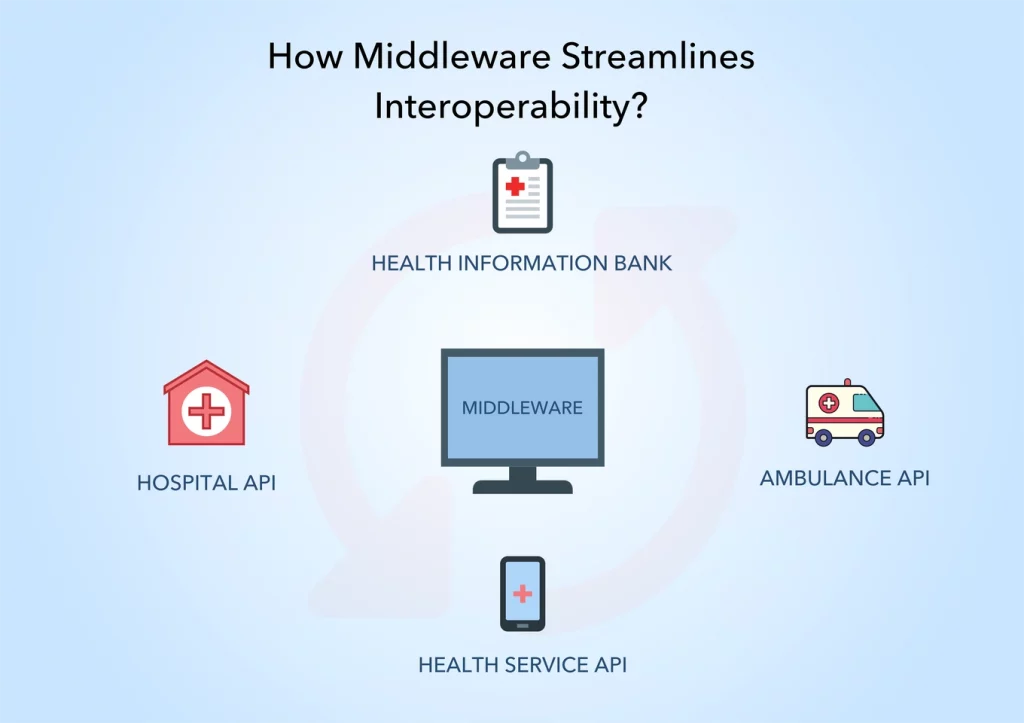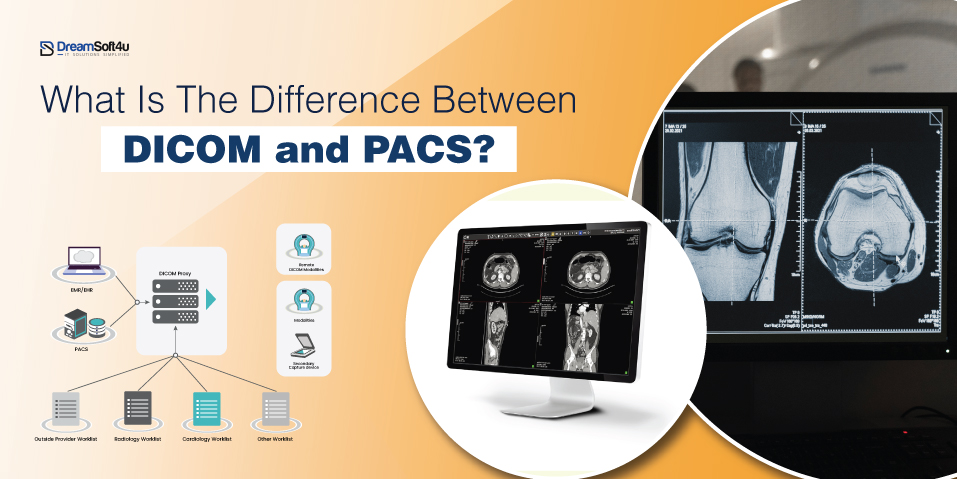In the healthcare IT realm, the impact of middleware software development on care delivery and outcomes has been most profound. Think of Middleware software solutions as the “glue” that connects disparate applications and systems, enabling seamless communication and data sharing in complex healthcare environments.
The demand for middleware software arises when handling diverse healthcare processes in one place becomes difficult. If you want to learn about middleware software solutions, keep reading this guide. We’ve covered everything about them, including their benefits, potential use cases, challenges, and best practices. So, without any further delay, let’s dive in!
Table of Contents
ToggleWhat is Middleware in the context of the healthcare industry?
Middleware is a custom healthcare software that acts as a bridge between different software applications, systems, and databases. It helps them connect seamlessly. It’s like a translator that allows different programs to understand each other and work together smoothly.
For example, imagine a hospital where the electronic medical records system needs to communicate with the billing system. Middleware software solutions enable these two systems to exchange data seamlessly, making it easier for doctors and administrators to provide quality care and manage finances efficiently. Middleware software development plays a crucial role in bridging the gaps between new and legacy systems. It enables the integration of healthcare applications, clinical workflows, and other health IT systems, ensuring seamless interoperability and data exchange.
Benefits of Middleware Software Development in Healthcare
Middleware software development offers several key benefits for healthcare organizations. These benefits include:
- Improved Data Management and Access
In healthcare, large volumes of data are generated daily, ranging from patient medical records to research findings. However, custom software development solutions provide scattered, unstructured, and diverse across different organizations and systems. Middleware software solutions address this challenge by consolidating and centralizing data into a unified database, making it easily accessible and eliminating the risks of data silos.
- Seamless Integration of Disparate Systems
Healthcare organizations often rely on multiple systems and applications that serve different functions. Middleware software acts as a bridge between these disparate systems, enabling smooth integration and communication. For example, a pharmaceutical manufacturing company may need to collaborate closely with clinical research centers. Middleware software development connects different groups and automates data-handling processes, reducing human errors, and enhancing operational efficiency.
- Enhanced Interoperability and Clinical Workflows
Interoperability is a critical aspect of healthcare, allowing different systems and applications to exchange data seamlessly. Custom healthcare software like Middleware connects EHRs with other healthcare systems and enables real-time access to patient data. This allows healthcare providers to make informed decisions and deliver high-quality, personalized care.
- Streamlined Operations and Efficiency
Middleware software solutions automate processes and workflows, reducing manual complexities, and improving overall efficiency. It saves time and resources, allowing staff to focus on providing quality care to patients. Middleware software development also optimizes workflows, eliminates redundancies, and enhances communication between healthcare providers, resulting in improved patient outcomes.
- Scalability and Future-Proofing
Healthcare organizations must adapt to evolving industry needs and new technology trends. Middleware software development provides scalability and future-proofing capabilities by enabling the seamless integration of new technologies and applications with existing systems. This flexibility allows healthcare organizations to embrace innovation without disrupting their operations or compromising data integrity. Middleware serves as a foundation for building a robust and adaptable health IT infrastructure.
Potential Use Cases for Middleware Software

Middleware software development has found numerous use cases in the healthcare industry. While the focus has primarily been on improving EHR interoperability and clinical workflows, there are several other areas where middleware solutions can be applied.
Some potential use cases include:
- Telemedicine and Remote Patient Monitoring
Middleware software can play a vital role in connecting telemedicine platforms with EHRs, ensuring seamless data exchange between healthcare providers and patients. It enables real-time monitoring, secure data transmission, and remote collaboration, enhancing the quality and accessibility of healthcare services.
- Medical Device Integration
RPM devices produce a vast amount of data that needs to be captured, analyzed, and integrated into the overall patient record. Middleware software development facilitates the integration of medical devices with EHRs and other healthcare systems, enabling real-time data monitoring and analysis.
- Health Information Exchange (HIE)
Health information exchange involves the secure sharing of patient data between different healthcare organizations and systems. Middleware software solutions provide the necessary infrastructure to facilitate HIE. It enables seamless data exchange, allowing healthcare providers to access comprehensive patient information regardless of the healthcare organization they belong to.
- Clinical Research and Trials
Middleware solutions can streamline clinical research and trials by connecting various stakeholders, such as researchers, clinicians, and pharmaceutical companies. It enables the efficient exchange of research data, enhances collaboration, and automates data handling processes. Middleware software development in this context improves the speed and accuracy of clinical trials, leading to faster drug development and improved patient outcomes.
Key Challenges in Healthcare Middleware Software Development
Implementing middleware software within a healthcare setting requires custom healthcare software development and comes with its own set of challenges. The primary ones include:
- Interoperability and integration issues
Healthcare organizations often have multiple sub-systems, such as electronic health record (EHR) systems, laboratory information systems, imaging systems, and more. These systems may use different data formats, communication protocols, and standards, making it difficult to exchange and integrate data effectively. Middleware solutions need to provide standardized interfaces and support for various healthcare data standards.
- Ensuring data security and privacy
Modern software development security risks are on the rise. Middleware solutions must employ robust security measures to protect patient information from unauthorized access, breaches, and data leaks. Encryption, access controls, authentication mechanisms, and audit trails need to be used to ensure data security. Additionally, compliance with privacy regulations, such as the HIPAA in the United States, is essential.
- Regulatory compliance considerations
Healthcare is a highly regulated industry, and middleware software developers must take into standards like HL7, DICOM (Digital Imaging and Communications in Medicine), and other regional or national healthcare data exchange standards. Additionally, adherence to data protection laws, patient consent requirements, and security regulations are critical to meet legal and regulatory obligations.
- Scalability and performance optimization
Healthcare generates a vast amount of data daily. Scalability becomes a significant challenge as healthcare organizations expand, and the volume of data increases exponentially. Middleware solutions should be designed to handle the growing data load, ensuring optimal performance and responsiveness. Techniques such as distributed computing, load balancing, and parallel processing need to be employed.
- Usability and user experience
While middleware software may not be directly accessed by patients, it plays a vital role in facilitating the smooth flow of information and processes within healthcare systems. It is crucial to ensure that healthcare professionals can easily interact with the middleware solution, access relevant information, and perform their tasks efficiently.
Trends and Innovations in Healthcare Middleware Software Development
- Adoption of HL7 FHIR standards for seamless data exchange
Healthcare organizations are increasingly adopting the HL7 FHIR (Fast Healthcare Interoperability Resources) standards for data exchange. FHIR is a modern and flexible approach to healthcare data exchange. Its use of RESTful APIs and standardized data elements simplifies the integration and exchange of healthcare data. - Cloud-based middleware solutions for increased flexibility and scalability
Cloud computing in healthcare offers enhanced flexibility, scalability, and cost-effectiveness. With cloud-based middleware solutions, healthcare organizations can easily exchange data between their on-premises and cloud systems while ensuring secure storage and processing of large volumes of healthcare data. - Integration of artificial intelligence (AI) and machine learning (ML) capabilities
AI and ML are reshaping the way healthcare organizations use patient data. AI and ML algorithms can analyze large datasets to derive valuable insights, predict patient outcomes, and assist in decision-making processes. - Embracing the IoT app development and wearables for real-time data collection
Today, middleware developers are incorporating IoT devices and wearables to collect real-time patient data, enabling continuous monitoring of vital signs and activity levels for timely interventions. - Implementation of blockchain technology for enhanced data security and integrity
Blockchain technology is being integrated into healthcare middleware software to ensure secure and tamper-proof storage of patient data, improving data security and maintaining data integrity.
Best Practices for Developing Middleware Solutions in Healthcare
Developing middleware software in the healthcare industry requires careful attention to detail and adherence to best practices. Here are some key guidelines to ensure successful development:
- Conduct thorough requirements analysis and system mapping
Start by understanding the specific needs and challenges of the healthcare environment. Analyze requirements in detail and create a comprehensive system map to guide the development process. - Adopt an agile development approach for iterative improvements
Agile methodologies promote flexibility and allow for continuous improvement. Break the development process into small, manageable iterations, ensuring regular feedback and incorporating changes as needed. - Prioritize data security and privacy throughout the development lifecycle
Healthcare data is highly sensitive, so robust security measures are paramount. Implement encryption, access controls, and data anonymization techniques to protect patient information. - Collaborate with healthcare professionals and end-users for usability testing
Involve healthcare professionals and end-users throughout the development process. Conduct usability testing to gather feedback and ensure that the software meets their needs effectively. - Implement robust monitoring and maintenance strategies
Middleware software in healthcare must be monitored closely for performance, stability, and security. Establish effective monitoring mechanisms and develop maintenance strategies to promptly address any issues that may arise.
Looking for Compliance-ready, interoperable Middleware Development?
Connect with our dedicated IT Professionals
Concluding thoughts
Middleware software development is revolutionizing the healthcare industry by enabling seamless integration, improving data management and access, enhancing interoperability, and streamlining clinical workflows. As healthcare organizations navigate the complexities of a rapidly evolving landscape, middleware solutions provide the foundation for building robust health IT infrastructure that supports innovation, scalability, and secure data exchange.
By embracing custom healthcare software development, hospitals, clinics, and healthcare providers can unlock the full potential of digital transformation and deliver exceptional patient care in an increasingly interconnected world.
FAQs:
Q1: What factors influence middleware software development cost?
Cost factors include:
- Project complexity: More complexity means higher costs.
- Required features: The number of functions impacts development costs.
- Integration needs: Connecting with multiple systems adds complexity and costs.
- Compliance standards: Meeting regulations like HIPAA increases effort and costs.
Q2: What’s the average middleware software development time?
Project timelines vary depending on scope, but typically range from 6 to 12 months. We’ll provide a detailed timeline based on your specific needs.
Q3: What’s the ideal team size, and what’s the approach?
Our team typically includes UI/UX designers, developers, QA specialists, and healthcare IT experts.. We use an Agile approach for flexibility and iterative development.
Q4: How do you secure healthcare data?
Data security is paramount. We prioritize security with Encryption, Regular audits, and Compliance adherence(HIPAA and GDPR).
Q5: What kind of support is provided after the software is launched?
We provide continuous support for your middleware:
- Troubleshooting: Addressing post-launch technical issues.
- Updates: Regular bug fixes and new feature additions.
- Enhancements: Adapting to changing needs and industry trends.























